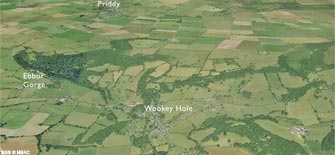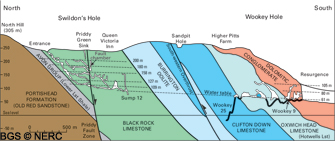
Wookey Hole and Ebbor Gorge
Wookey Hole and Ebbor Gorge are two geological gems nestling under the southern flank of the Mendip Hills. The Ebbor Gorge National Nature Reserve is a delightful wooded limestone gorge with way-marked trails and great views while Wookey Hole is a show cave and paper mill.
Wookey Hole
Wookey Hole, the source of the River Axe, was once considered one of the wonders of Britain. The cave, now open to the public, was formed by the underground River Axe and is slightly unusual in that it is formed not in Carboniferous Limestone but in Triassic Dolomitic Conglomerate.
The River Axe can be seen flowing through the cave, and it resurges at the head of the ravine near the show-cave exit. It has been followed upstream by cave divers through several deep water-filled sumps to the present limit of exploration at a depth of 90 m. The river drains much of central Mendip, including most of the caves in the Priddy area. Both Wookey Hole and several small caves in the ravine outside have yielded important archaeological finds, including the bones of the 'Witch of Wookey' (on show in the Wells and Mendip Museum) and a Romano-British cemetery.
Ebbor Gorge
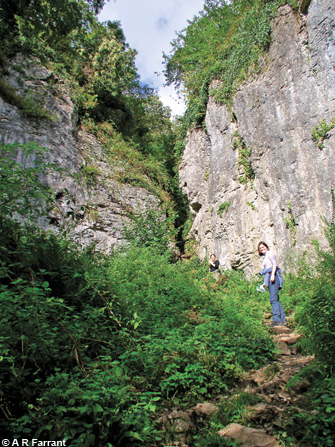
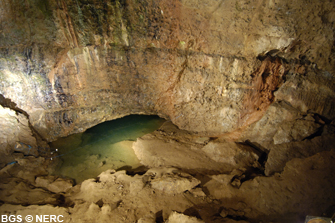
Ebbor Gorge is a National Nature Reserve with both geological and wildlife importance. Here a slice of the Burrington Oolite has been thrust up over the younger Quartzitic Sandstone and the Coal Measures along the Ebbor Thrust. The gorge itself is incised into the Clifton Down Limestone. This spectacular ravine was formed by summer meltwater run-off during cold phases in the Pleistocene, when underground drainage was prevented by permafrost. The narrowest part of the gorge (The Narrows) forms a prominent 'knick point'. This former waterfall is a consequence of valley rejuvenation during the Pleistocene cold periods.
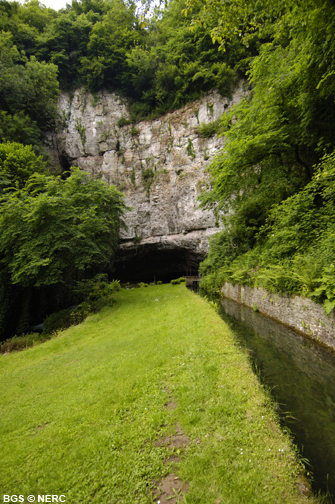
The steep rocky limestone slopes are cloaked in ancient ash woodland with many ancient woodland species, while the rocky crags, cliffs and screes are home to many ferns, mosses, liverworts, lichens and fungi. Butterflies are abundant and many rare species can be found.
Quarrying and mining
Iron, lead, limestone and coal were all once mined in the Wookey and Ebbor area. Iron ore was mined in the 1890s at Higher Pitts Farm. The ore was associated with a unique assemblage of rare secondary lead, copper and manganese minerals. These minerals, Mendipite, Chloroxiphite and Diaboleite are rare or unknown outside the Mendip area. Lead was mined from rakes in the limestone between Pen Hill and North Hill. A thin belt of Coal Measures strata occurs in Primrose valley, at the foot of Ebbor Gorge.
Coal was mined here from a shaft 36 m deep in 1835, but the seams were very thin and only a small amount of coal was mined. The most important commodity was limestone. The Burrington Oolite was quarried from two sites on Milton Hill, now both disused, for aggregate and lime. Quarrying in the larger quarry in 1935 intercepted a vertical fissure which contained remains of hippopotamus and straight-tusked elephant. These date from the Ipswichian interglacial, about 120 000 years ago. The remains are in the Wells and Mendip Museum.
- Home
- Overview maps
- Locality
areas
- Cheddar Gorge
- Charterhouse
- Blackdown
- Burrington Combe
- Shipham & Rowberrow
- Crook Peak & Axbridge
- Banwell to Churchill
- Priddy
- Harptree & Smitham Hill
- Draycott & Westbury-sub-Mendip
- Wookey Hole & Ebbor Gorge
- Wells
- Great Elm & Vallis Vale
- Mells & the Wadbury Valley
- The Vobster area
- The Whatley area
- Torr Works & Asham Wood
- Beacon Hill
- Stoke St Michael & Oakhill
- Holwell & Nunney
- Shepton Mallet & Maesbury
- Gurney Slade & Emborough
- The Nettlebridge valley
- Geology
- Minerals and mines
- Quarrying
- Caves and karst
- Biodiversity
- Detailed site information
- Acknowledgements
- External links
- Search
- Site map
